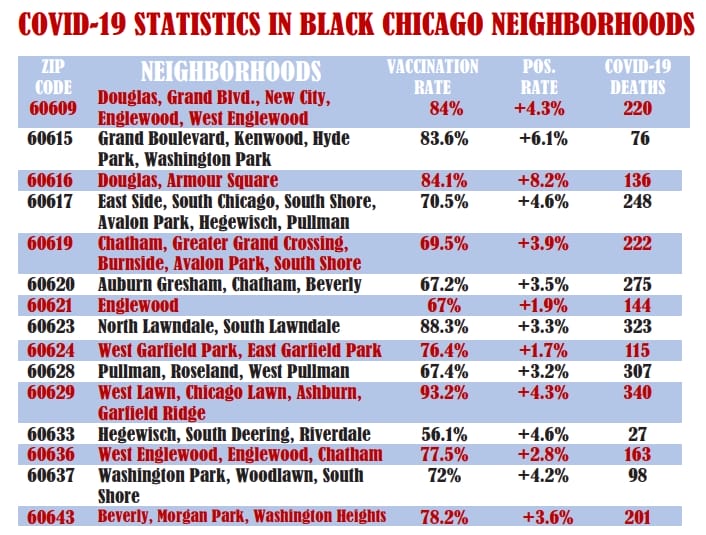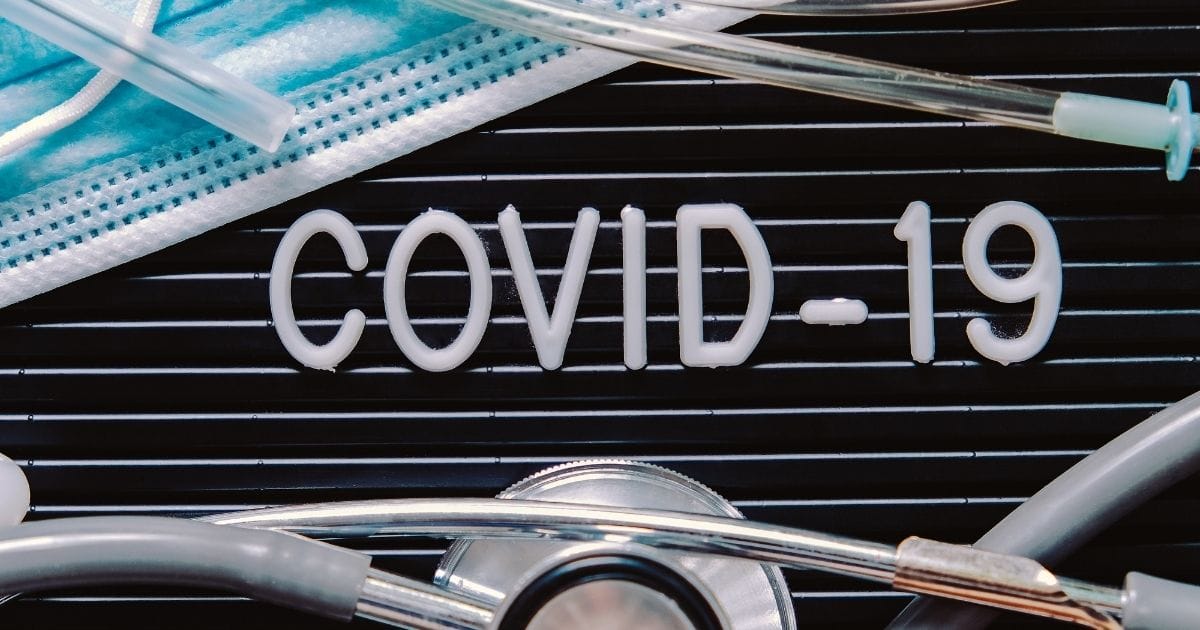As Chicago moved to high-risk status in COVID-19 transmissions, five people in the city’s Black zip codes died in one week, according to a Crusader analysis of data from the city’s COVID-19 dashboard.
Though low compared to recent months, that weekly death toll on the South and West Sides is the highest since the week ending May 3 when seven people died of the disease.
In the latest data, over a seven-day period, at least one person died in zip codes 60619 (Chatham, Greater Grand Crossing, Burnside, Avalon Park), 60628 (Pullman, Roseland, West Pullman), 60629 (West Lawn, Chicago Lawn, Ashburn, Garfield Ridge), 60643 (Beverly, Morgan Park, Washington Heights) and 60649 (South Shore).
Since the pandemic began in Chicago in 2020, the city’s Black population has disproportionally been hit the hardest.
As of May 13, approximately 12 out 20 zip codes had positivity rates higher than the previous week. But the city reported a 5.9 percent positivity rate that was lower than the previous week.

One day before the Memorial Day Weekend, Chicago’s medium risk status climbed to high risk as the city braced for an estimated 1.4 million visitors during the unofficial start of the summer season.
Cook County was also placed in high risk status as new cases continued to climb. Other high-risk counties include DuPage, Lake, McHenry, Will, Grundy, Boone, Lee and Winnebago in northern Illinois, and Fulton, Knox, Henderson, Mason, Peoria and Tazewell in central Illinois, the statement read.
Despite Chicago’s high risk transmission status, the city’s mask mandate will not be reinstated but health officials are now strongly urging everyone to wear masks in indoor public settings and advising against non-essential indoor gatherings for people who are at high risk of severe outcomes from COVID-19.
Most businesses in Chicago are not reinstating their own mask mandates and crowded airports in the city and the country remain mask free as the Omicron sub variant BA.2 continues to spread with new cases.
The Chicago Department of Public Health (CDPH) said mask mandates will be reinstated if COVID-19 hospitalizations increase significantly and Chicago’s hospital capacity is threatened.
“We’ve been watching the data and expecting this development for a few weeks now,” said CDPH Commissioner Allison Arwady, M.D.
“Along with a high number of cases, our regional health service area is starting to see some more COVID-19 hospitalizations. Thankfully, Chicago hospitals are still doing well and have plenty of capacity.
“Thanks in large part to vaccines, boosters, and early treatments, we currently have just over 200 confirmed COVID patients hospitalized across all 34 of our city’s hospitals, compared to nearly 2000 COVID patients hospitalized in early January.”
With the move to a High COVID Level, CDPH strongly urges masking in all public indoor spaces in Chicago, including on public transit. Chicagoans should also ensure that they and everyone in their social networks are up to date with COVID-19 vaccines and boosters; test when they experience COVID-19 symptoms; and continue to follow all isolation and quarantine requirements.
Chicagoans with underlying conditions or who are older should also seek early treatment if they are diagnosed with COVID-19, to decrease the risk of hospitalization.
As a reminder, everyone aged 5 and older should receive a booster dose five months after their initial vaccination. People aged 50 and above, and those 12 and above with compromised immune systems, should also receive a second booster, four months after their first booster.
The CDC determines COVID-19 Community Levels as Low, Medium, or High, based on the number of new local COVID-19 cases, regional COVID-19 hospital admissions, and COVID-19 hospital capacity in the prior week.
The CDC’s measurement of hospitalization data for Community Levels reflects the burden on the whole federally defined Health Service Area, which includes Cook, Lake, DuPage, and McHenry Counties.
There are early signs that the surge may be peaking, both in the Midwest and the Northeastern U.S. Case counts have started to plateau or trend down, though they remain very high overall.
 In official CDC data, Cook County (combining Chicago and suburban Cook data) reported 324 COVID-19 cases per 100,000 residents over the past seven days–which was actually a slight decrease from last week, when it was 338. The goal is to get back under 200 cases per 100,000 residents per week.
In official CDC data, Cook County (combining Chicago and suburban Cook data) reported 324 COVID-19 cases per 100,000 residents over the past seven days–which was actually a slight decrease from last week, when it was 338. The goal is to get back under 200 cases per 100,000 residents per week.
While 76 percent of Chicagoans aged 12 and older have completed their primary COVID-19 vaccine series, just 42 percent have also had the recommended vaccine booster. Children over 5 are now eligible for boosters. People aged 50 and over are also eligible for a second booster, but among Chicagoans age 65 and older, just 58 percent have had even one booster.
Chicago continues to offer free Pfizer vaccines, including first and second boosters, to all Chicagoans through Protect Chicago At Home. Schedule an appointment at your home, on your schedule (including evenings and weekends) through chicago.gov/athome or by calling 312-746-4835.
Last month the Food and Drug Administration (FDA) approved the Pfizer booster for children 5 to 11. However, children in that age group are lagging overall when it comes to COVID-19 vaccinations.
As cases rise, the FDA is will review data from Moderna and Pfizer trials on children 6 months to 5 years on June 15.






